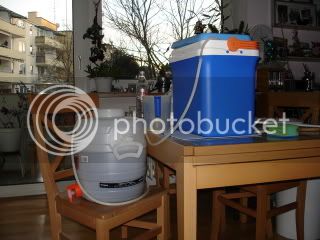Pok!
Still laughing at FNQBunyip's post. HTFU has recently become a QLD catch-cry! If you haven't heard of it, send Bunyip a PM and he'll explain it - it's pretty funny.
Anyway, Bunyip and apd got into AG using the BIAB link that Bunyip provided above. When you read that link, you'll see that I've had a fair bit to do with brewing in a bag and am quite passionate about seeing guys in your position at least start with this method because I have been in your position.
I read and read and got totally confused. Luckily, Ross invited me up to watch one of his traditional brews (by traditional I mean batch or fly-sparging, Ross batches) and then he came down to help me with my first. This two day process involved drinking a myriad of beers but luckily Ross took photos.
I ended up writing
A Guide To Mashing And Batch Sparging It needs a re-write but I think as it is a distillation/combination of all the stuff I read and was taught it is well worth a read. Hate blowing my own trumpet as it's other people's wisdom and help that I'm passing on but I do know that a lot of guys found those notes of great help.
I have actually gone from the traditional method to brewing in a bag. I have several reasons for doing so that I'll list below. I'm going to have a crack at listing them in order. I'll try and list in order of importance but that will be hard as every brewer's requirements/expertise are different. You also have to bear in mind that I'm a bit of a perfectionist so if quality were an issue, you would find me writing essays in other areas of AG. Because of this, I'm listing quality first but of more interest to you I imagine (as these were things that worried/confused me when considering a move to AG) would be expense and knowledge - they're a bit further down.
1. Quality: I
know can brew a beer of equivalent quality to a beer brewed traditionally. I've brewed some better ones as well. (I've also brewed some crap beers but not because of the method.) So far, and there has been many a beer brewed in a bag now (Bunyip and I have done at least 400 litres each probably more), no one has been able to detect a difference or unfavourable aspect of a beer that has been BIABed. I have always actively encouraged people to find faults. To date we have found none. Even in a side by side brew done followed by triangular testing, only one experienced could find a difference and the difference was equivalent not negative.
2. Equipment/Expense: To BIAB, you need a bag, burner, a kettle and a thermometer the latter being as important than the other two. With traditional, you need another two major vessels. These add cost and are not are not easy to control without even more cost . POL, who baby-sat me through my early AHB days, who always writes great posts and to whom I haven't written to or thanked in way too long, has listed that equipment above. This equipment, without extra expense, also makes it hard to control your mash in the first 25 minutes.
3. Knowledge: Even though the current BIAB guide is not written as well as it could be (for example, it talks about an 'escalator mash' which I don't think any of us have ever done - seemed a good idea at the time of writing though!) it has still got a lot more people over the fence into AG than the 'Mashing and Batch-Sparging Guide' has done. It allows you to concentrate on the essence of brewing without a quality loss.
4. New/Exciting: I like areas that are new and exciting. I love building stuff. I love electronics. I love gadgetry. This is a whole new world of BIAB that has not been explored yet. I have ideas but no space or workshop - spewing! There is so much that can be done here. In fact, the only guys I can think of that have gone from BIAB to traditional have done so for this reason (of these few, I know at least a couple that still incorporate the bag into their traditional brewing.) At the moment, BIAB is more manual than technical. I'm hoping that this will change.
5. Space/Cleaning: I brew in an apartment so space and cleaning are major considerations. Only wrote one sentence here but this is at least a third of brewing importance.
6. Brewery Output Increase: My needs of brewing ideally require me brewing 2 different beers every fortnight. If I buy one extra vessel, I can brew these 2 different beers on the same day using/cleaning all the same equipment (apart from one extra kettle) and only costing me an extra hour. Later I can rack/filter/keg at the same time. In other words, the above advantages repercuss. This is a huge bonus and I probably should have put it second on the list.
7. Brewing Variations: One last thing that excites me about BIAB is that with a little engunuity, anyone can explore easily the differences in mashing temperature regimes. While this is unimportant to anyone starting AG, it's an area that I find fascinating now and am sure, will do so even more in days to come.
Well Pok, that's probably my longest and most coherent post in at least a month. I've been very tired lately and posting poorly. Hope this one makes up for it. Has anyone even read this far?
LOL
Pat
 :chug:
:chug:





